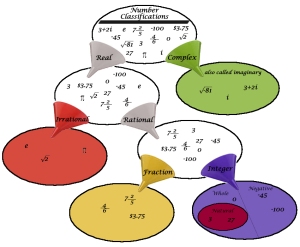Today’s topic is another foundational math concept – number classification! (I can hear you snoring cheering already!)
So what’s the big deal, right? A number’s a number, isn’t it? Well, yes and no, just like a square is a shape with certain attributes, numbers themselves can be categorized. Take the chart I have so cleverly created. (BTW, if you need it to study or use in a classroom, take it! If you need a better size, or the original .png file, let me know!)
The first great divide of numbers is if they are Real or Imaginary. Imaginary numbers result from trying to take the square root of a negative number. They most often occur in the school realm when you are trying to find where a parabola intersects with the x-axis. If it doesn’t intersect, your answer will be an imaginary number. They have lots of other uses and they will definitely be the subject of a future post. Real numbers, on the other hand, are the ones we use everyday.
- Decimals – how much your paycheck is worth,
- fractions – a quarter of a cup of sugar,
- and integers – You owe Joe $5 and you only have $3, you still owe Joe money (hopefully he’s not the gangster type…),
are all examples of Real numbers.
When you break Real numbers down, there are irrational and rational numbers – not so different from people :P.
Irrational numbers, much like some people I know, go on and on forever, without end, (much like this post if I’m not careful 🙄 ). Examples of irrational numbers are Euler’s e, and
. These numbers have approximate values, but, in fact, are infinitely long decimals. In contrast, rational numbers do end, and can always be expressed as a fraction. Examples of rational numbers include 27, -43,
and $403.99.
A subset (smaller group) of rational numbers is integers. These numbers are the ones that have 1 as the bottom of the fraction (denominator), such as 34, -17, and 0. If the integer is 0 or a positive number, we call even call it a whole number. With the exception of 0, all whole numbers are also called natural, or counting, numbers (because we count with them – there are 5 fingers on my hand, I can’t be -7 feet tall…although sometimes I feel that way :|).
Well this has been the longest post so far, but hopefully it has presented the number family tree in an easy understandable fashion 🙂
Now go read something fattening, you just gave your brain a workout.
